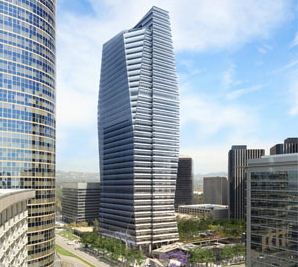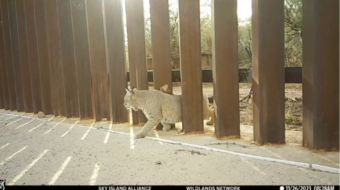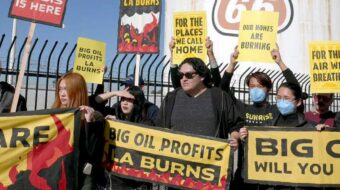
LOS ANGELES – After years of refuting thoroughly debunked arguments against it, the Century City Center has been approved by a Jan. 27 unanimous 12-0 vote of Los Angeles City Council. This victory was the result of a massive, several years-long organizing campaign involving environmental groups, unions, and concerned citizens. Sustained leadership came from Clergy and Laity United for Economic Justice (CLUE), a pro-labor coalition of faith movements with deep community roots.
The Century City Center will be paramount in leading the way for the private sector to adopt premier environmental LEED standards while still creating over 6,000 union jobs for workers. This will ensure that working families will have a living wage and healthcare while it protects the environment. This project, and the campaign to support it, puts Los Angeles at the forefront of justice-oriented city planning for the nation.
What is LEED? LEED is the acronym for Leadership in Energy and Environmental Design. LEED certification means that the construction conforms to the current best practices in conservation, access, sustainability, environmentally friendly materials, and wise energy use. It is the building industry’s green stamp of approval, granted on four levels: Certified, Silver, Gold, and Platinum.
The Century City Center will be the first LEED Platinum-certified high-rise building in Los Angeles and only the sixth in the nation. Here are just some of the features that the City Council approval has guaranteed:
* Century City Center will create 6,000 good jobs, some during construction and others permanent. A Project Labor Agreement ensures that the project is built with union labor.
It will also generate $4.3 million to the City of Los Angeles every year and generate $400 million in annual economic activity throughout the county.
* The environmentally friendly aspects of the project include: 7,000 square feet of solar photovoltaic panels; one of the largest habitable green roof spaces in California; a high-performance central plant that produces ice at night to melt during the day and provide efficient cooling; a passively cooled lobby using windows, fresh air, and a chilled lobby floor with a high-tech water feature that rejects heat; and reclaimed water from the building for landscape irrigation.
* Century City Center will feature a large public plaza. with shops, kiosks, and plentiful plantings, trees and shade, that will take advantage of existing transit options, as well as provide a ready connection to future advances as a potential portal location for the planned Purple Line mass transit Metro station. One of the key ways that the project will encourage transit use is the inclusion of a 1,300 square-foot mobility hub to assist the 50,000 employees who work in Century City and who want to get out of their cars and use alternative commuting strategies.
The project is a good example of the vertical growth of cities along the routes of major transit systems.
Century City is a large outcropping of modern commercial buildings in West Los Angeles built on a tract that once served as Twentieth Century Fox movie lots. Its towering office buildings housed the offices of retired President Ronald Reagan. Its fancy hotels were the scene of militant demonstrations – and a famous L.A. police riot – during the Vietnam War years when Lyndon Johnson would come to town.
So why was the City Council approval such a victory? The project would likely not have been controversial at all, except for the fact that JPMorgan Chase & Co., a leading global financial services firm and one of the largest banking institutions in the world, has a high-rise office building just across the street from the proposed building site. A handsome new LEED-certified office building would inevitably pose strong competition for office rental space.
A major effort was made in well-to-do neighborhoods near the project, many presume with funding from JPMorgan Chase, to oppose authorization for building, on the grounds that traffic patterns in West Los Angeles would be profoundly affected, and that streams of commuters in their single-occupancy cars would be barreling through quiet, tree-lined streets where children play stick ball. Homeowners, fearing for their safety and property values, plastered their lawns with signs opposing the project.
Fortunately, this argument proved specious to the City Council members who voted on Tuesday. They held hearings during the attenuated approval process at which representatives of the Catholic Church, various Protestant churches, the Jewish Labor Committee, Faith to Green, CLUE, the Sierra Club, the Natural Resources Defense Council and other organizations testified to the excitement and wisdom of building green and fair.
Rabbi Jonathan Klein, executive director of CLUE, mused somewhat sadly on the fate of Van Jones, President Obama’s early “Green Czar,” whose mandate was to bring environmental awareness to federal policy and create “an entire new green sector for new jobs.” But Jones was drummed out of office by a concerted GOP-led attack, meaning that green leadership necessarily passed back into the hands of the private sector.
It is expected that the City Council approval may yet be subject to dilatory lawsuits and appeals, but for now the victory is being savored.











